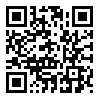Volume 5, Issue 2 (Journal of Language Teaching, Literature & Linguistics (JLTLL) 2022)
JSAL 2022, 5(2): 255-282 |
Back to browse issues page
Download citation:
BibTeX | RIS | EndNote | Medlars | ProCite | Reference Manager | RefWorks
Send citation to:



BibTeX | RIS | EndNote | Medlars | ProCite | Reference Manager | RefWorks
Send citation to:
Taslim Jahromi F, Ghasemi N. (2022). Analysis of plot structure in Qaboosnameh [In Persian]. JSAL. 5(2), 255-282.
URL: http://jsal.ierf.ir/article-1-75-en.html
URL: http://jsal.ierf.ir/article-1-75-en.html
1- Assistant Professor of Persian Language and Literature, Faculty of Literature and Humanities, Jahrom University , ftaslim@yahoo.com
2- Master's degree in Persian language and literature, Faculty of Literature and Humanities, Jahrom University
2- Master's degree in Persian language and literature, Faculty of Literature and Humanities, Jahrom University
Abstract: (1326 Views)
Qaboosnameh is an educational and ethical book written by Onsor Al-Maali Kikavous, one of Alziar's rulers, in the fifth century for his son Gilanshah. This book has many literary and social values, so that it is considered a collection of pre-Mongol Iranian civilization. The author has used historical and social anecdotes and stories to influence and emphasize his words throughout the book. These stories are told to explain ethical points, and a special context of storytelling can be observed in them. One of the fictional elements that is clearly prominent in Qaboosnameh anecdotes is the narrative element. This research has analyzed the descriptive-analytical form by randomly selecting fifteen anecdotes from Qaboosnameh, the structure of the narrative in this work according to the beginning of the story, story triangle, denouement and complication, etc. In addition to the structure of the plot and how it is formed and its process in the story, two main and effective elements in the narrative such as characterization and perspective have also been explored. According to the results of this research, Onsor Al-Maali has benefited from new storytelling methods in Qaboosnameh anecdotes in addition to expressing moral points consciously and unconsciously. This factor has increased the impact and intimacy of its stories. Onsor Al-Maali has also made innovations in terms of perspective and has expressed a new perspective by combining several perspectives. In his view, although he is aware of all the events, he refrains from narrating all the events, excessive bias and details, and leaves the decision to the reader.
Type of Study: Research |
Subject:
Discourse Analysis
Received: 2021/06/26 | Accepted: 2021/07/11 | Published: 2021/08/8
Received: 2021/06/26 | Accepted: 2021/07/11 | Published: 2021/08/8
Send email to the article author
| Rights and permissions | |
 |
This work is licensed under a Creative Commons Attribution-NonCommercial 4.0 International License. |






